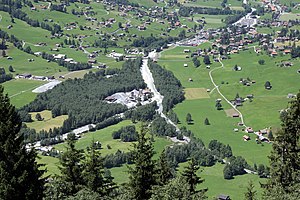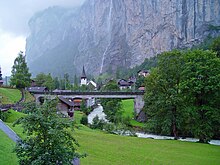Lütschine
| Lütschine | ||
|
The catchment area of the Lütschine |
||
| Data | ||
| Water code | CH : 500 (united Lütschine), Schwarze Lütschine 501, Weisse Lütschine 502 | |
| location |
Bernese Alps
|
|
| River system | Rhine | |
| Drain over | Aare → Rhine → North Sea | |
| Start on | Confluence of the Schwarzer and Weisser Lütschine at Zweilütschinen 46 ° 38 ′ 2 ″ N , 7 ° 53 ′ 54 ″ E |
|
| Source height | approx. 646 m above sea level M. | |
| muzzle | in Lake Brienz Coordinates: 46 ° 41 '27 " N , 7 ° 53' 53" E ; CH1903: 635 143 / 171180 46 ° 41 '27 " N , 7 ° 53' 53" O |
|
| Mouth height | 564 m above sea level M. | |
| Height difference | approx. 82 m | |
| Bottom slope | approx. 8.9 ‰ | |
| length | 9.2 km (with Schwarzer Lütschine 29.8 km) |
|
| Catchment area | 386 km² | |
| Discharge at the Gsteig A Eo gauge : 381 km² |
NNQ (1934) MNQ 1924–2016 MQ 1924–2016 Mq 1924–2016 MHQ 1924–2016 HHQ (2005) |
1.35 m³ / s 15.2 m³ / s 18.8 m³ / s 49.3 l / (s km²) 23.4 m³ / s 254 m³ / s |
| Discharge at the level of mouth A Eo : 386 km² |
MQ Mq |
19.72 m³ / s 51.1 l / (s km²) |
| Left tributaries | Saxetbach | |
|
The Weisse Lütschine in Lauterbrunnen Valley near Stechelberg |
||
|
The Schwarze Lütschine (right) and its tributary the small Weisse Lütschine (left) in Grindelwald-Grund |
||
The Lütschine (also: United Lütschine ) is a 9.2 km long river alone and together with the Black Lütschine 29.8 km long river in the Bernese Oberland in Switzerland . It is a southern and left tributary of Lake Brienz and thus indirectly also the Aare .
Surname
The name Lütschine comes from the Celtic name leucos, leuca , which means “white” or “bright, shiny”. This means that the name “Weisse Lütschine”, which, confusingly, is borne by two rivers in the Lütschine system, is a pleonasm in literal history .
geography
Source rivers
White Lütschine
The Weisse Lütschine from the Lauterbrunnen valley is the 19.4 kilometer long, left and southern source river of the Lütschine.
With its upper course, the Tschingel-Lychina, it forms the course of the Tschingelfirn . It has several side streams that plunge in high waterfalls over the steep rock faces into the Lauterbrunnen Valley , including the Staubbach Falls , the Trümmelbach Falls and the Schmadribach Falls . The Mürrenbachfall applies with 417 meters height as the highest waterfall in Switzerland.
Finally it unites at Zweilütschinen at an altitude of 646 m above sea level. M. with the Black Lütschine approaching from the east to the Lütschine.
Black Lütschine
The Black Lütschine from Grindelwald is the 20.6 kilometer long Black Lütschine , right and eastern source river of the Lütschine.
It drains the Upper Grindelwald Glacier and the Lower Grindelwald Glacier . The 2.7 kilometer short discharge of the latter is again called Weisse Lütschine ( watercourse number 5709) and flows into the Schwarze Lütschine in the valley floor below Grindelwald. Above this confluence, the Swiss Federal Office for the Environment classifies the Black Lütschine as a stream, while the short Weisse Lütschine as a river.
At Zweilütschinen it finally flows together with the Weisse Lütschine coming from the south.
Further course
From Zweilütschinen the now unified river flows first in a north-westerly direction through the narrow Lütschinental and is fed on the way first on its left by Riedgraben , then on the right by Sylergraben and then again on the left by Rufigraben .
The Lütschine now reaches Gsteigwiler , flows around the higher place in the west and then turns its direction to the northeast. At the entrance to Wilderswil , it is reinforced on its left by its longest tributary, the Saxetbach , which comes from the Saxettal in the southwest . Then it moves east past Wilderswil and the Gsteig church .
It then runs over the Bödeli to Bönigen , where it finally reaches an altitude of 646 m above sea level. M. flows into Lake Brienz.
Its 9.2 km long run ends about 82 meters below the confluence of its source rivers, so it has a mean bed gradient of about 8.9 ‰.
Catchment area
The 386 km² catchment area of the Lütschine lies in the Bernese Alps and is drained to the North Sea via the Aare and the Rhine .
It consists of 21.6% wooded area , 27.1% agricultural area , 1.7% settlement area , 18.6% glacier / firn, 0.6% water area and 30.3% from unproductive areas.
The area distribution

The mean height of the catchment area is 2020 m above sea level. M. , the minimum height is 563 m above sea level. M. and the maximum height at 4144 m above sea level. M.
Tributaries
Inflows from the confluence to the mouth with name, orographic direction , length in kilometers, catchment area in km², point of mouth, mouth height. The names of the streams come from the WebGIS of the canton of Bern, some of the data from swisstopo .
- Black Lütschine ( right source river ), 20.6 km, 179.89 km², 9.67 m³ / s
- Weisse Lütschine ( left source river ), 19.4 km, 165.0 km², 8.35 m³ / s
- Üssere Fäldligrabe ( left ), 0.4 km
- Birchgrabe ( left ), 0.4 miles
- Lammgrabe ( right ), 0.4 km
- Chelligrabe ( right ), 1.0 km
- Riedgrabe ( right ), 1.4 km
- Nüwimattegräbli ( left ), 0.5 km
- Sylerwaldgrabe ( left ), 0.7 km
- Sylerbach ( left ), 2.2 km, 2.89 km²
- Schüpfigräbli ( left ), 0.6 km
- Dangelgrabe ( left ), 1.0 km
- Rufigrabe ( right ), 1.6 km, 0.55 km²
- (Bach from the) Härdig-Schleif ( left ), 1.1 km
- Louwigrabe ( left ), 1.6 km, 0.57 km²
- Bänisriedgräbli ( left ), 0.6 km
- Rotebächli ( left ), 0.8 km
- Saxetbach ( left ), 10.2 km, 21.22 km², 1.05 m³ / s
- (Bach from the) Chässchleif ( right ), 0.5 km
- Sagislouener ( right ), 1.4 km
- Chrummi Louene ( right ), 0.4 miles
- (Bach from the) Pfengischleif ( right ), 1.2 km
- Marchgrabe ( right ), 0.7 km
- (Bach from the) Härdigschleif ( right ), 1.1 km
- Gsässgrabe ( right ), 1.7 km
Hydrology
Discharge data
At the confluence of the Lütschine in the Brienzersee, its modeled mean flow rate (MQ) is 19.72 m³ / s. Her discharge regime type is a-glacio-nival and her discharge variability is 13.

The Lütschinen containment
The Lütschine, which comes from the Grindelwald and Lauterbrunnen valleys, is a mountain river rich in debris and suspended matter, which used to erupt repeatedly during extreme floods and flood the entire Bödeli with the villages on it and the Interlaken Provostry. It can be assumed that the Lütschine already flowed into Lake Brienz at the time when the Augustinian Canons settled in Bödeli around 1130 and was not, as is often claimed, diverted there by them. Only one of its estuary arms, which ran along the Changeberg towards Bönigen , was built with a longitudinal dam on the left bank. The monastery people from Interlaken played an important role in this. For centuries, generations of the affected population invested a lot of time and money to put the boisterous mountain water in its place.
A small part of the water was diverted in the Middle Ages for various uses. The narrow Spülibächli canal carried Lütschinenwasser to the Interlaken monastery , where it powered various mills and was used for cleaning purposes.
In 1831 the Lütschine broke out shortly after the confluence of the Saxetenbach near Wilderswil and poured through this village over the Bödeli to Matten and Interlaken. The result was a one meter thick overburden , the traces of which can still be seen on some old houses today. A contemporary report noted: "... the Saxetenbach united (with the Lütschine) broke through the dam, came down over all fields, some of the inhabitants of Matten made to emigrate"
The last time the Lütschine erupted during the Alpine floods in 2005, it flooded the lower part of Wilderswil and large parts of the Bödeli . After the motorway cut was filled, the water flowed through mats and into the Aare as far as Interlaken .
Web links
- The catchment area of the Lütschine at the geoportal of the canton of Bern
Individual evidence
- ↑ Geoserver of the Swiss Federal Administration ( information )
- ↑ a b c d Modeled mean annual discharge. In: Topographical catchment areas of Swiss waters: sub-catchment areas 2 km². Retrieved January 19, 2020 .
- ↑ Gsteig measuring station 1924–2016 (PDF) Federal Office for the Environment FOEN
- ↑ Fishing in the Lütschinen on the website of the Economic, Energy and Environmental Directorate of the Canton of Bern, accessed on July 9, 2020
- ↑ Direction of view upstream despite the line of sight pointing downwards
- ↑ Florian Spichtig, Christian Schwick: Mürrenbachfall. In: Waterfall.ch. Retrieved June 26, 2012 .
- ↑ Julia Slater: Waterfalls: Which is the tallest in the whole country? In: swissinfo.ch. March 1, 2010, accessed May 26, 2012 .
- ↑ "Hidden behind the mean values" - the variability of the discharge regime , p. 7
- ↑ The discharge variability describes the extent of the fluctuations in the mean discharge of individual years around the long-term mean discharge value.





